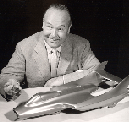
Tough Guys and Pretty Boys:
The Cultural Antagonisms of Engineering and Aesthetics in Automotive History
The Triumph of Stylists in the 1950s
From 1942 to 1945, the battle between stylists and engineers was eclipsed by the international hostilities of World War II. Civilian automobile production was suspended in these years, and the factories of automakers were converted into freedom’s arsenal, producing millions of tanks, trucks, jeeps, planes, and guns. With the coming of victory, however, the auto industry entered a period of rapid expansion that ensured a similar triumph of the pretty boys over their tough guy rivals. Beginning in the late 1940s, the nation experienced a postwar economic expansion that created an explosion of consumer spending. Auto sales skyrocketed, due both to the pent-up demand from the war years and the entry of a vast number of newly prosperous consumers into the new-car market for the first time. Because the Depression years had eliminated many small automakers, this rapidly expanding auto market was left almost entirely to the control of what came to be known as the Big Three--General Motors, Ford, and Chrysler. Within this automotive oligopoly, competition through price and engineering innovation gave way to less costly competition through style. Consequently, styling departments in the Big Three expanded exponentially, and the stylists reigned supreme in all the automakers. They unilaterally dictated auto designs, with engineers reduced to trying to make their increasingly outrageous dream machines run. If, for example, stylists wanted cars closer to the ground to make them appear sleeker and faster, engineers scrambled to redesign frames, suspensions, and engines to facilitate this.
During the 1950s Harley Earl set the direction of style, dictating that cars become not only lower but longer and wider as well. Following the precept of this expansive period that “bigger is better,” he sought to offer consumers the psychic compensation of big cars to convince them that their lives were indeed better. As George Walker, head of styling at Ford, told Popular Mechanics in 1959: “The American public is aggressive, it’s moving upward all the time . . . and that means bigness. When the American workingman gets a little money he wants a bigger house and he wants a bigger car.” Earl and other stylists also offered consumers the dream of flight, and earthbound autos sprouted tail fins, air scoops, jet exhausts, and canopy windshields. Plagiarizing jet plane and rocket design was popular because these connoted advanced technology and exciting escape from terrestrial worries and cares. Further, during this period of escalating Cold War tensions, these visual associations with America’s military technology swelled consumers with feelings of national pride and power.
Despite the purely symbolic nature of most of these 1950s features, stylists felt compelled to offer some flimsy functional excuses for their design excesses, perhaps to assuage consumers' guilt about such automotive extravagance. Tail fins were said to stabilize cars in crosswinds, despite the fact that tests showed this effect was achieved only at speeds higher than sixty miles per hour. Big, heavy cars were said to be safer, for they "held the road" and protected passengers in collisions. But in reality these larger cars were more unsafe, for improvements in steering and braking lagged substantially behind increases in power and size. Lower cars were said to improve handling and lessen the dangers of rollover, but both claims were largely erroneous. Finally, wraparound “canopy” windshields were said to improve the driver’s vision by eliminating corner pillars, while in reality the curved glass created dangerous distortions of sight. These problems mattered little to the industry, however, for it was convinced that consumers were unconcerned with safety. And indeed, this conviction seemed to be validated in 1956, when Ford tried to catch Chevrolet sales by making safety a selling point. In this year the company promoted its Lifeguard Design cars, which came equipped with safety features like seat belts, padded dash, dished steering wheel, breakaway rearview mirror, and crash-proof door locks. But the safety campaign failed to boost Ford sales past the stylish Chevrolets. And Harley Earl himself offered an explanation of why “safety doesn’t sell.” People drive for fun, Earl stated, and being conscious of the possibility of accidents spoils their fun. "If you were on a boat, you would not want life preservers all over the table; it suggests too much."
Introduction
The Utilitarian Vision of Henry Ford
General Motors Style Overtakes Ford Efficiency
The Changing American Character
The Struggle for Styling in the Early Industry
The Depression Era Battle for Streamlining
The Triumph of Stylists in the 1950s
Contradictions of Fantastic Styling and the Stylists' Fall From Grace
Stylists Fight Back with "AERO"
Postindustrial Lifestyle Cars & The New Balance of Power Between Engineers and Designers
Complete Text Printable View
©2004 Automobile in American Life and Society


